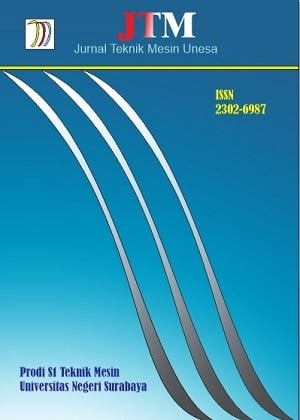EKSPERIMENTAL PENGARUH VARIASI PANJANG PADA UJUNG SUDU BERPENAMPANG L TERHADAP KINERJA TURBIN CROSSFLOW POROS HORIZONTAL
Abstract
Current power plants are continuously being developed in line with the rapidly increasing supply of electricity production. This situation is inversely proportional to energy sources that are dwindling every year. With the existence of renewable energy sources such as sun, wind, water, and so on, it can be used to replace non-renewable energy. The abundant water potential in Indonesia that can be used as a small-scale Micro-hydro Power Plant (PLTMH). At this time, many impulse turbines have been developed where the potential energy of water is converted into kinetic energy, which is capable of operating at low heads. The purpose of this study was to determine the effect of variations in length at the end of the blade with a cross-section of L in a crossflow turbine. This study uses an experimental method by varying the length at the end of the L-section blade using a turbine without an end and the variations in the length of the tip of the blades used are 10 mm, 15 mm, 20 mm, 25 mm which will be tested with variations in water capacity of 9.572 L/s, 11.024 L/s, 14,322 L/s, 16,. 152 L/s, and 18,113 L/s with various loadings of 500 g, 1000 g, 1500 g, 2000 g until the turbine stops. The results showed that turbines with blade end lengths of 10 mm had the most optimal performance compared to blade tip lengths of 15 mm, 20 mm, and 25 mm. The highest power is obtained in a turbine with a blade end length of 10 mm at a capacity of 18,113 L/s with a 9000 gram loading of 5,912 Watt. The highest efficiency was also obtained at the blade end length of 10 mm at a capacity of 11.024 L/s with a loading of 4000 grams of 82.94%. While the turbine without an end has the lowest performance compared to other turbines. This is because the turbine with a blade end length of 10 mm is able to utilize the water flow well and the distance between the tip of the blades is further which results in more water being accommodated so that it is able to drive a more powerful turbine which can produce high rpm and greater torque even though it is given a higher load.
Keywords : Crossflow, Power, Efficiency, Turbine, L Blades.
Downloads
 Abstract views: 162
,
Abstract views: 162
, PDF Downloads: 187
PDF Downloads: 187


